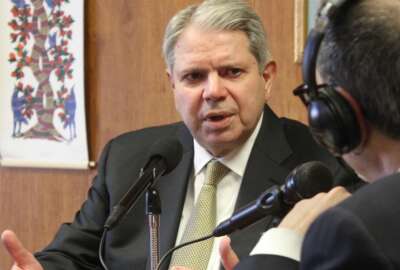One hundred new ways the government gets wrapped around its axle
Fragmentation, duplication and overlap. There is too much of it in government programs. It degrades economy and efficiency. Each year the Government Accountability...
Fragmentation, duplication and overlap. There is too much of it in government programs. It degrades economy and efficiency. Each year the Government Accountability Office (GAO) details instances of multiple agencies doing the same thing. This year GAO found what if calls “100 new matters for congressional consideration.” For the highlights, Federal Drive with Tom Temin spoke with Jessica Lucas-Judy, the GAO’s Director of Strategic Issues.
Interview Transcript:
Tom Temin And just briefly, for people that may not be aware of this great list every year, fragmentation, duplication, overlap. Just give us the quick definitions of what those are.
Jessica Lucas-Judy Sure. So fragmentation is where you have multiple agencies or more than one agency that are trying to serve a population or deliver services and they could coordinate better. Sometimes it’s difficult for recipients to be able to find who to go to when they have questions or there’s different rules that make it difficult to deliver those services. Overlap is where you have agencies that are serving similar populations or similar types of goals. And then duplication is where you’re actually serving the same people or providing the same services.
Tom Temin All right. And each year you identify where this is across the government and your recommendations, unlike most GAO recommendations, are to Congress itself for fixing a lot of things legislatively.
Jessica Lucas-Judy That’s right. We have both kinds of recommendations in this report. So the 100 new recommendations that we identified this past year, some of those are to executive branch agencies and some of them are matters for Congress where they’re things that need to be fixed legislatively.
Tom Temin And what are the highlights of these hundred new matters? Four of them are defense, which is already a big source of duplication and overlap in many ways. But what did you find in defense that has popped up?
Jessica Lucas-Judy Well, some of the new areas that we identified for this past year relate to the fragmentation that I was talking about, where there are multiple entities within DoD or DoD and some of its partners that are fragmented and they could be better coordinated. And so artificial intelligence is one of the areas that we identified where the research that’s going on and ways to use artificial intelligence effectively for defense and supporting the warfighter need to be better coordinated and you need a strategy for managing those. We also found one of the areas that we’ve highlighted in prior years, but continues to be an issue is in Navy shipbuilding, where it’s important to make sure that the contracts are in place. And we think that you could save billions of dollars by more effectively managing those programs.
Tom Temin Got it. And you also mentioned DoD predictive maintenance. Military services should each designate a single entity with sufficient authority to do this kind of program. And when you say the military services should each designate. That doesn’t mean one for the entire Defense Department, but maybe just one for each armed service, which would reduce fragmentation and duplication.
Jessica Lucas-Judy Right. So predictive maintenance is instead of waiting for something to break and then fixing it, which can lead to backlogs and not being always the most efficient way to manage maintenance. To use data analytics, got a lot of information that’s available on when certain services might be needed, and each one of the services within DoD could designate an entity that would help manage those programs and cut down on maintenance backlogs.
Tom Temin And how do you philosophically determine which types of activities should be consolidated, de-duplicated or whatever, versus those that maybe need to happen in a diffuse manner? AI is a good example. Every agency can think of a way to do AI for its own mission. So should that be centralized or should whatever is trying to be centralized disband and let everybody pursue their own? I make the analogy of cafeterias. Every building needs its own for practical purposes. You couldn’t have a single centralized cafeteria for the entire federal government.
Jessica Lucas-Judy Exactly right. And one of the things that we emphasize in our work is that just the presence of duplication or of overlap by itself is not necessarily a bad thing. What we’re identifying is ways to better manage that duplication or that overlap or the fragmentation and try to make it work more effectively, more efficiently. And that enables the government to be able to serve more people or to reduce costs, to have money that’s available in other areas. One of the examples in this year’s report is on broadband. So you’ve got the entire country is trying to make sure that people have access to broadband, whether that’s for education or for health care even or for job searches or for doing work online. It’s really important to have high speed Internet available. And there are people who don’t even have reliable broadband. And you have more than 130 different programs across 15 federal agencies that are trying to address this problem. And, some of them are serving different populations. Some of them are providing the infrastructure, some are providing devices, some are providing training to be able to use these things. And. We’re not saying that those need to be eliminated, but you do need a strategy to make sure that across the government they’re all working towards similar goals and they know who’s responsible for doing what. And to share information more effectively to make sure that we’re getting what people need.
Tom Temin We’re speaking with Jessica Lucas-Judy. She is director of strategic issues at the Government Accountability Office. And this kind of duplicative effort and fragmentation happens in international affairs, which must really be confusing for overseas recipients of U.S. largesse.
Jessica Lucas-Judy Right. That’s another area that we identified, several places where a strategy or better coordination was needed, whether it was in providing AIDS relief in other countries or another. One of the areas that we identified was in commercial diplomacy, where state and commerce departments should make sure that they were using leading practices in collaboration to manage the fragmentation in the support that they provide to businesses, to U.S. businesses working overseas.
Tom Temin Okay. And just to add all of this up, I mean, what does GAO estimate is the cost of all of this fragmentation, duplication and overlap? And how much could Congress save if it nailed down every one of them, which is a stretch?
Jessica Lucas-Judy Right. Well, just to preview a product that we have that’s going to be coming out in a few weeks, we are attempting to use models to estimate more precisely the amount of savings that could be available. But so far in the duplication and cost savings body work that we’ve done, we’ve identified more than 800 recommendations to Congress and to federal agencies. More than two thirds of those have been fully implemented, and so far we have identified about $600 billion in savings that’s been realized from addressing those recommendations with the 527 recommendations that are still open. We think that there are tens of billions of dollars in potential savings that are out there. One example that we highlighted in the report is a recommendation to Congress from a 2016 report that we did, and this was for Congress to direct HHS to equalize payments in Medicare between the place of service. So whether the services are provided in a doctor’s office or a clinic or hospital to equalize those payments for the same services just depends on where they’re provided and that the Congressional Budget Office has scored that as $141 billion in savings just from that one recommendation alone.
Tom Temin And some of these things linger for years, as you point out. Like one of them is sale of unneeded federal real property. This is the General Services Administration in general is responsible for this. They’ve been hacking away at congressional mandates and programs to try to identify and then dispose of properties for at least a decade. And a few little parking lots and ramshackle garages have been gotten rid of, but they’re still large vacant areas. And I don’t know, somehow it never seems to happen.
Jessica Lucas-Judy That is an area that’s been on GAO’s High Risk List for a number of years now. And one of the things that we highlighted in this year’s report is that there was an effort that GSA had underway to be able to dispose of unneeded property. It was supposed to happen in three phases. And the first phase, they were able to sell and receive about $195 million in sales. But when it came time to moving on to the second phase, the board that was supposed to oversee this was some of the members left. So the effort sort of has fizzled out a bit. And so we’re recommending that GSA coordinate on identifying lessons learned from the first couple of phases and implement this going forward. And if they find that there are legislative barriers, that they identify ways that Congress could make changes to help them do that better in the future.
Tom Temin And do you ever identify areas where maybe the government just shouldn’t be doing anything in the first place, like shutting down some programs?
Jessica Lucas-Judy We have identified programs in some places where in prior years where we felt like there was, sort of too much duplication or duplication in a way that wasn’t effective. And we’ve made recommendations to agencies and to Congress to be able to eliminate unneeded programs, whether that was overlapping programs in STEM education or in subsidies that were being provided for certain types of fuel that were then duplicating efforts that were there elsewhere. And so we’ve identified those in prior years, too, and then able to make some changes.
Copyright © 2025 Federal News Network. All rights reserved. This website is not intended for users located within the European Economic Area.
Tom Temin is host of the Federal Drive and has been providing insight on federal technology and management issues for more than 30 years.
Follow @tteminWFED






